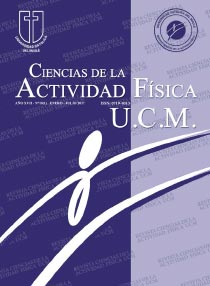Álvarez, J., Sánchez, S., Corbi, F., Pagès, T., & Visco, G. (2012). Valoración de la frecuencia cardíaca de recuperación después de un programa de entrenamiento fuerza-resistencia en hipoxia. Apunts Med Esport, 23-29.
Borg, D. A. (1982). Psychophysical bases of perceived extertion. Medicine and Science of Exercise, 377-387.
Chatterjee, S., Chatterjee, P., & Bandyopadhyay, A. (2005). Validity of queen's college step test for estimation of maximum oxygen uptake in female students. Indian J Med Res, 32-35.
Chatterjee, S., Chatterjee, P., Mukherjee, S., & Bandyopadhyay, A. (2004). Validity of Queen’s College step test for use with young Indian men. Br J Sports Med, 38: 289-291.
Cooper. (1979). The new aerobics. New York: M. Evans And Company, Inc.
Forteza, A., & Ramírez, E. (2005). Teoría, metodología y planificación del entrenamiento: (de lo ortodoxo a lo contemporáneo). Sevilla: Wanceulen.
Gene, A. (2002). Exercise physiology laboratory manual. New York: McGraw-Hill Publishers.
Jiménez, A. (2005). Entrenamiento personal bases, fundamentos y aplicaciones. Barcelona: Inde Publicaciones.
López, J., & Fernández, A. (2006). Fisiología del ejercicio (3a Ed.). Buenos aires: Médica Panamericana.
McArdle, Katch, F., Pechar, G., Jacobson, L., & Ruck, S. (1972). Reliability and interrelationships between maximal oxygen intake, physical work capacity and step-test scores in college women. Medicine and Science In Sports, 182-185.
Nieman, D. C. (2011). Exercise testing and prescription a healt-related approach. New York: Mc Graw Hill Connect Learn Succeed.
Santo, A., & Golding, L. (2003). Predicting maximum oxygen uptake from a modified 3-minute step test. American Alliance for Health, Physical Education, Recreation and Dance, 110-114.
Sucianu, A. (1980). Determinación indirecta del consumo máximo de oxígeno. 77-81.
Tanaka, H., Monahan, K. D., & R. Seals, D. (2001). Age-predicted maximal heart rate revisited. Journal of the American College of Cardiology, 153-155.
Wilmore, J., & Costill, D. (2007). Fisiología del esfuerzo y el deporte (6a Ed.). Badalona: Paidotribo.


